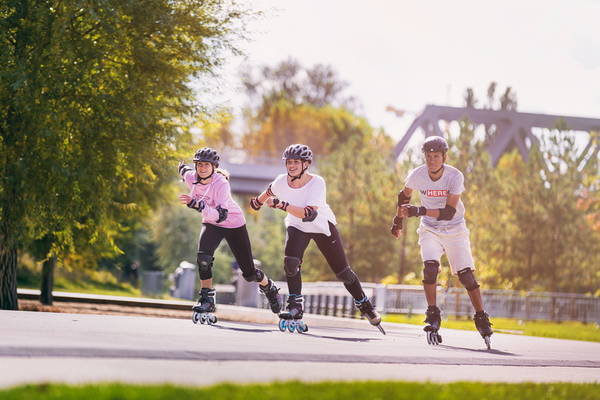Basic Techniques for Inline Skating

Mastering proper inline skating requires developing a stable posture on the skates, learning how to stop safely, turning with ease, and knowing how to fall correctly. This guide will teach you everything you need to begin with inline skating techniques.
Inline skating is for everyone, regardless of size or age. All you need is a pair of inline skates, some protective gear, and a smooth surface free from traffic to start practising. The initial learning phase may be challenging, yet you will notice improvements after just a few hours, so keep at it!
Overview
Stance on Inline Skates
To maintain the correct posture on your inline skates, ensure you bend your knees. This lowers your centre of gravity, aiding balance.
Your feet should be positioned parallel when skating, directed straight ahead rather than inwards or outwards.
By keeping your knees bent, feet parallel, and upper body leaning slightly forward, you cultivate a stable and balanced stance.
Check out our tutorial video, How to Skate on Inline Skates:
Stopping Techniques for Inline Skates
Several methods are available to slow down, either by utilising the brake pad or employing the T-stop technique. Both are detailed in our instructional video, How to Stop on Inline Skates:
Stopping with the Brake Pad
The brake pad method involves moving the skate with the brake forward and elevating your toes to bring the brake pad into contact with the ground, thereby reducing speed. Using this technique, you can control your speed efficiently or bring yourself to a halt. For novices, familiarising yourself with the brake pad is advised for maintaining control.
The T-Stop Approach
The T-stop technique includes placing one foot behind while dragging the wheels perpendicular to the other foot, creating a T shape. Maintain the drag until a full stop is achieved. Proficiency in balancing on one foot is necessary for performing a T-stop while rolling.
Achieving a stoppage using the wheels alone, without relying on a brake pad, can be advantageous as pads may sometimes obstruct. Beginners are advised to explore the T-stop to enhance their overall control over inline skating.
Turning Techniques in Inline Skating
Ensure a slight forward lean and bent knees while turning. For a left turn, position the left foot forward slightly; for a right turn, do the opposite. Shift your weight towards the desired direction and lean into the turn, looking in the turning direction for assistance.
By refining your turning techniques, you can prevent common beginner errors and pave the way for learning more advanced tactics such as the cross-over turn as you advance.
Safe Falling Methods on Inline Skates
When falling, aim to fall forward, as this facilitates control over the fall and prevents injury to your head or tailbone.
If balance is compromised on skates, consider the following measures:
- Crouch and lean forward—staying low reduces fall impact and may help regain control.
- Utilise protective gear—landing on knee, elbow, or wrist pads absorbs impact, minimising injury. If moving swiftly, slide on these protectors to avoid scrapes.
Employing these tactics will help reduce injury likelihood, ensuring continued progress in inline skating.
Choosing the Ideal Inline Skates for Learning
It's essential for both beginners and experienced skaters to select inline skates that fit well and provide comfort. Beginner skates should feature a heel brake and robust ankle support. Opt for softer wheels (76A - 84A) that are not overly large—adults with large feet should consider sizes up to 84 mm, while children's sizes should remain under 70 mm.
Read through our buying guides for further advice on choosing inline skates:
